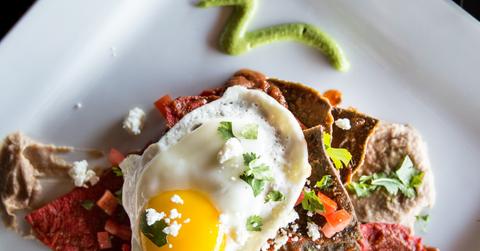This 'Revolutionary Farm' Produces World's First Carbon-Neutral Egg
Calling themselves a "revolutionary farm," the Dutch company Kipster has employed a handful of green methods to create the world's first carbon-neutral egg.
Updated May 26 2019, 5:03 p.m. ET
In general, raising livestock takes a huge toll on the environment. For perspective, farming animals produces from 20 to 50 percent of all man-made greenhouse gas emissions in the world. While chickens are lower on the carbon scale than, say, cows, producing eggs is still generally unsustainable: One kilogram of egg protein (what you'd get from about 10 dozen eggs) releases about 4.8 kilograms of CO2 into the atmosphere.
But there's good news for egg lovers out there: The Dutch company Kipster is claiming to have created the world's first carbon-neutral egg. Calling themselves a "revolutionary farm," which prioritizes animal welfare, environmental sustainability and social responsibility, Kipster has employed a handful of green methods to offset the carbon footprint of producing eggs.
The farm is fitted with almost 1,100 solar panels, which powers the entire establishment and produces more energy than the farm needs, the remainder of which they sell. Kipster also raises white chickens, which eat less than their brown counterparts and therefore save on raw materials; use an extremely low ammonia standards; don't use any fossil fuels; uses chicken feed produced from food waste rather than corn, which is a huge tax on the environment; and has reduced fine particle emissions by more than 90 percent.
Additionally, when the chickens "retire" (a.k.a. stop laying eggs), "they are not dumped...but they are processed here into high-quality meat products," according to the company's website.
The farm is also an innovative haven for the chickens. The modular design of its facility features an atrium where the chickens live, which is designed like a "natural wooded environment" for the chickens to roam free in. There is plenty of variety, daylight and fresh air; the indoor garden has been set up as a kind of playground for the chickens; and the multitude of plants in the garden give them plenty to do.
"For us, laying chickens are more than just egg machines that have to be set at maximum yield," the website reads. "We see the chicken as an animal with instincts and needs. In the design of the farm, the chicken is the main focus. We show that animal welfare is definitely a realistic option in combination with environmentally friendliness as well as financial feasibility."
The farm will serve as a center for agro-food innovations. Companies, organizations and students with innovative products or ideas will be able to present them in a meeting room overlooking the peaceful chicken garden, and the building will also feature changing exhibitions around the themes from the agro-food chain, from cultivation to consumption, and all the links in between.
To top it all off, the modular setup is easily replicated and scaled. Farms with 3,000 to 96,000 chickens are possible in a myriad of environments – including urban settings – and has proven to be a viable alternative to conventional agriculture
"Using common sense and high-quality technology, we have developed a farm where the chicken is allowed to be a chicken again, and the environment is spared as much as possible."
